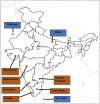Biochemical and Proteomic Characterization, and Pharmacological Insights of Indian Red Scorpion Venom Toxins
- PMID: 34650430
- PMCID: PMC8505525
- DOI: 10.3389/fphar.2021.710680
Biochemical and Proteomic Characterization, and Pharmacological Insights of Indian Red Scorpion Venom Toxins
Abstract
The Indian red scorpion (Mesobuthus tamulus) is one of the world's deadliest scorpions, with stings representing a life-threatening medical emergency. This species is distributed throughout the Indian sub-continent, including eastern Pakistan, eastern Nepal, and Sri Lanka. In India, Indian red scorpions are broadly distributed in western Maharashtra, Saurashtra, Kerala, Andhra Pradesh, Tamil Nadu, and Karnataka; however, fatal envenomations have been recorded primarily in the Konkan region of Maharashtra. The Indian red scorpion venom proteome comprises 110 proteins belonging to 13 venom protein families. The significant pharmacological activity is predominantly caused by the low molecular mass non-enzymatic Na+ and K+ ion channel toxins. Other minor toxins comprise 15.6% of the total venom proteome. Indian red scorpion stings induce the release of catecholamine, which leads to pathophysiological abnormalities in the victim. A strong correlation has been observed between venom proteome composition and local (swelling, redness, heat, and regional lymph node involvement) and systemic (tachycardia, mydriasis, hyperglycemia, hypertension, toxic myocarditis, cardiac failure, and pulmonary edema) manifestations. Immediate administration of antivenom is the preferred treatment for Indian red scorpion stings. However, scorpion-specific antivenoms have exhibited poor immunorecognition and neutralization of the low molecular mass toxins. The proteomic analysis also suggests that Indian red scorpion venom is a rich source of pharmacologically active molecules that may be envisaged as drug prototypes. The following review summarizes the progress made towards understanding the venom proteome of the Indian red scorpion and addresses the current understanding of the pathophysiology associated with its sting.
Keywords: Indian red scorpion; catecholamines; pathophysiology of scorpion sting; therapy against Mesobuthus tamulus scorpion sting; venom composition.
Copyright © 2021 Das, Saviola and Mukherjee.
Conflict of interest statement
The authors declare that the research was conducted in the absence of any commercial or financial relationships that could be construed as a potential conflict of interest.
Figures
Similar articles
-
Development of a gold nanoparticle-based novel diagnostic prototype for in vivo detection of Indian red scorpion (Mesobuthus tamulus) venom.Toxicon X. 2024 Aug 18;23:100203. doi: 10.1016/j.toxcx.2024.100203. eCollection 2024 Sep. Toxicon X. 2024. PMID: 39263685 Free PMC article.
-
The geographical distribution of scorpions, implication of venom toxins, envenomation, and potential therapeutics in Southern and Northern Africa.Toxicol Res (Camb). 2024 Aug 4;13(4):tfae118. doi: 10.1093/toxres/tfae118. eCollection 2024 Aug. Toxicol Res (Camb). 2024. PMID: 39100857 Free PMC article. Review.
-
Correlation of Venom Toxinome Composition of Indian Red Scorpion (Mesobuthus tamulus) with Clinical Manifestations of Scorpion Stings: Failure of Commercial Antivenom to Immune-Recognize the Abundance of Low Molecular Mass Toxins of This Venom.J Proteome Res. 2020 Apr 3;19(4):1847-1856. doi: 10.1021/acs.jproteome.0c00120. Epub 2020 Mar 12. J Proteome Res. 2020. PMID: 32125869
-
In vitro laboratory analyses of commercial anti-scorpion (Mesobuthus tamulus) antivenoms reveal their quality and safety but the prevalence of a low proportion of venom-specific antibodies.Toxicon. 2022 Aug;215:37-48. doi: 10.1016/j.toxicon.2022.06.001. Epub 2022 Jun 5. Toxicon. 2022. PMID: 35675849
-
Scorpions and scorpion sting envenoming (scorpionism) in the Arab Countries of the Middle East.Toxicon. 2021 Feb;191:83-103. doi: 10.1016/j.toxicon.2020.12.017. Epub 2020 Dec 31. Toxicon. 2021. PMID: 33387549 Review.
Cited by
-
Development of a gold nanoparticle-based novel diagnostic prototype for in vivo detection of Indian red scorpion (Mesobuthus tamulus) venom.Toxicon X. 2024 Aug 18;23:100203. doi: 10.1016/j.toxcx.2024.100203. eCollection 2024 Sep. Toxicon X. 2024. PMID: 39263685 Free PMC article.
-
A Novel Therapeutic Formulation for the Improved Treatment of Indian Red Scorpion (Mesobuthus tamulus) Venom-Induced Toxicity-Tested in Caenorhabditis elegans and Rodent Models.Toxins (Basel). 2023 Aug 14;15(8):504. doi: 10.3390/toxins15080504. Toxins (Basel). 2023. PMID: 37624261 Free PMC article.
-
The geographical distribution of scorpions, implication of venom toxins, envenomation, and potential therapeutics in Southern and Northern Africa.Toxicol Res (Camb). 2024 Aug 4;13(4):tfae118. doi: 10.1093/toxres/tfae118. eCollection 2024 Aug. Toxicol Res (Camb). 2024. PMID: 39100857 Free PMC article. Review.
-
Scorpion Sting Envenomation, a Neglected Tropical Disease: A Nationwide Survey Exploring Perspectives and Attitudes of Resident Doctors from India.Am J Trop Med Hyg. 2023 Sep 11;109(4):957-964. doi: 10.4269/ajtmh.23-0194. Print 2023 Oct 4. Am J Trop Med Hyg. 2023. PMID: 37696517 Free PMC article.
-
Editorial: Venoms and Toxins: Functional Omics and Pharmacological Insights.Front Pharmacol. 2022 Apr 27;13:887513. doi: 10.3389/fphar.2022.887513. eCollection 2022. Front Pharmacol. 2022. PMID: 35571136 Free PMC article. No abstract available.
References
Publication types
LinkOut - more resources
Full Text Sources
Research Materials



